June 2025
Pauljan Truyens, Sarah Vis, Sien Van de Wouwer & Ike Picone
Today, the Reuters Institute for the Study of Journalism publishes its annual Digital News Report, for which imec-SMIT-VUB is the Belgian partner. The report features a Country Page for Belgium with use and trust data for the most important Belgian news brands.
This policy brief summarises the most important findings on Flemish news use in 9 important trends. We conclude by raising a few questions about what specifically the figures on young people mean for the future of news media. All key trends are also available online in Dutch on www.nieuwsgebruik.be or you can download this policy brief in Dutch below.
Curious how these findings fit in with previous evolutions? Then be sure to take a look at our updated NEWS MONITOR.
Key Trends
9 key trends
| 1. More Flemish people use fewer different news sources The Flemish news user is generally involved with news, shows interest in news and has a fairly high level of trust in Flemish news media. However, 16% only use one or even no news source every week, while this was only 5% in 2017. |
| 2. Too much news is the main cause of news avoidance Although ever more Flemish people indicate that they sometimes avoid the news (64%), those really turning away from news are limited to 8%. The abundance and the negative nature of the reporting are the main reasons for avoiding news. |
| 3. Flemish people are less open to AI in journalism than last year Half of Flemish news users do not feel comfortable with artificial intelligence as anews producer. This is also strikingly true for 18- to 24-year-olds. Especially reliability & transparency of AI are questioned. |
| 4. Personalised news is met with little resistance Flemish news users are generally positive about personalisation in the news, which in terms of appreciation is no less than personalisation on streaming platforms. |
| 5. Only 1 in 5 Flemish people are satisfied with content moderation on social media platforms Content moderation remains a controversial topic, as only 1 in 5 Flemish news users are satisfied with how social media companies moderate their platforms, and opinions on the approach differ widely, including political persuasion. |
| 6. People are concerned about disinformation, but that doesn't necessarily mean they verify questionable information Concern about fake news online grew to around 45% among Flemish news users. in 2025 (+25pp compared to 2018). Yet around one in four would not use any news source to verify fake news. |
| 7. Influencers and activists are seen as the main sources of disinformation Social media platforms TikTok, Facebook and X in particular are associated with disinformation, with influencers, activists and foreign politicians seen as the main sources of disinformation. |
| 8. Half of young people have had media literacy training, and those rely more on news sources to check information Young people (18-24) in particular are increasingly using AI bots, social media sources and comment sections to verify information, although more young people with media training than without use news sources to check information. |
| 9. There is a great need for local news, but social media also fulfill this need perfectly About 75% of Flemish news users are interested in local news to some extent, although this is significantly less among young people, and news media are not always seen as the best source for it. |
1. More Flemish people use fewer different news sources
The majority of Flemish people still turn to different news sources every week: 47% of Flemish news users consult two to four different news sources per week and about 37% even more than four sources. On the other hand, 16% of Flemish people use a maximum of one source per week, while in 2017 this was only 5%. Furthermore, half of this group does not even consult any news source and according to them only gets the news via social media or social contacts.If we compare the Flemish news users who use no or one news source weekly with those who

If we compare the Flemish news users who use no or one news source weekly with those who use two or more, we see that the first group consists predominantly of women (65%) and also contains more people with lower levels of education than the second group. Finally, it is mainly Flemish people with an unspoken political preference who use one or no news source on a weekly basis.
Furthermore, the use of a limited number of sources goes hand in hand with a lower frequency of news use. Among Flemish news users who use no or only one news source every week, 43% consult the news less than once a week. If they do consult the news, this is mainly via social media (29%), online (25%) and TV (21%). Although the majority (85%) use social media, only 38% do so to consult the news. The lack of a multitude of news sources therefore translates
into a limited diversity of access routes to news.
It is also striking that those who use only one or no news source every week make much less use of Flemish news brands than the Flemish who consult 2 or more news sources every week. Only a small minority of this group frequently consults the news brands of VRT (offline: 11%;online: 6%) or of popular newspapers (offline: 15%; online: 9%). They hardly use quality newspapers (offline: 1%; online: 0%).
Less surprisingly, those who use no or only one source weekly also show less interest in the news: 47% of them are not interested in the news, 81% say they avoid the news, and 67% do not trust the news – compared to only 14%, 66%, and 47% respectively of those who use two or more news sources weekly.
This trend has been emerging for a few years now: among a small but growing number ofFlemish news users, a decreasing diversity of news sources, a decreasing frequency of news use and an increasing distrust in news are converging into a negative attitude towards the news, which may already have consequences for the reach of Flemish news media, but certainly will in the future, and therefore deserves to be closely monitored.
2. Too much news is the main cause of news avoidance
There is a slight upward trend in news avoidance in Flanders: in 2025, 64% of Flemish news users indicate that they sometimes or often avoid the news, while in 2017 this was only 48%.
The number of news avoiders is particularly high among women, people with a low income and 35–44-year-olds. For example, 70% of women occasionally avoid the news, compared to 60% of men. Within the lower income groups, 73% indicate that they avoid the news, compared to 60% among the higher income groups. The highest proportion of news avoiders can be foundin the 35-44 age group (73%). In comparison: it is only 61% among people aged 55 and over.
Although more Flemish news users indicate that they avoid the news, the number of actual news dropouts appears to have decreased compared to last year: 8% of Flemish people indicate that they consult the news less than once a week (while this was still 13% in 2024). It is striking that among young people (18-24 years) a proportionally larger number (16%) are tuning out the news. We can therefore state that an increasing number of people in 2025 indicate that they avoid the news (64%), while a decreasing number (8%) of Flemish people are effectively turning their backs on the news.
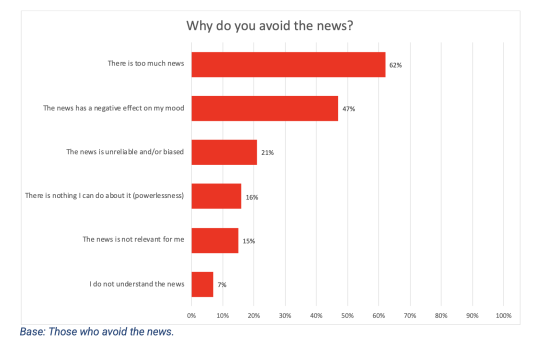
Equally striking is that among the people who indicate that they (occasionally) avoid the news, most do so because of the abundance of news reporting and news being too negative. The negative tone of the news is a growing reason for people to avoid the news: 42% of news avoiders already gave this as a reason in 2017, in 2022 this was 38% and in 2025 again 47%. But the most important reason for turning away from the news is because there is too much news: in 2025, 62% of news avoiders give this as the main reason (in 2022 this was 60%).
3. Flemish people are less open to AI in journalism than last year
Artificial intelligence is here to stay, including in journalism. While editors are figuring out how to use generative and other AI as efficiently and ethically as possible, it is interesting to note that Flemish news users are not more, but less open to the use of AI in news production than last year.
When it comes to artificial intelligence as a tool for journalists, only 22% of Flemish news users indicate that they feel comfortable with it. When asked which applications of AI in news they would use, 25% of Flemish people indicate that they are interested in using AI-generated summaries of news articles and 22% in using AI translations of news articles. There is certainly little interest in automatic text-to-audio/video.
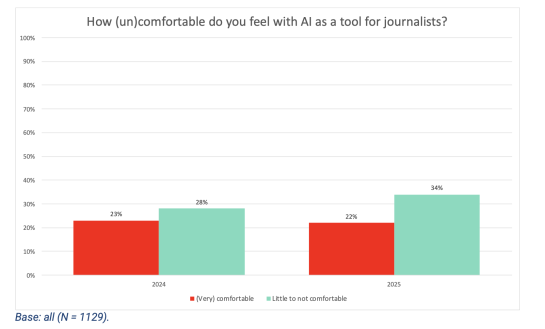
Less surprising but no less relevant is that Flemish news users are even stricter about AI as news producer. Half of Flemish news users indicate that they do not feel comfortable with news that is mainly produced by AI, with limited control from a journalist. Last year, only 13% indicated that they did not feel comfortable with this.
This may indicate a growing awareness among Flemish news users about what AI in journalism entails, as well as its pitfalls. In addition, this translates into different genres of media production: Flemish news users feel least comfortable with AI as a news producer when it comes to 'hard' news (68%), compared to sports for example (59%).
It is striking that young people clearly feel less comfortable with AI as a news producer. Where last year 30% indicated that they did not experience any problems with this, now only 13% say
they feel comfortable with this. Although social media and reporting on AI sometimes suggest otherwise, it appears that young people are indeed aware of the downside of artificial intelligence when it comes to news production.
Flemish news users question the transparency and reliability of AI as a news producer in particular. Two characteristics that are crucial when it comes to qualitative journalism and thus offer a possible explanation for the increased reluctance.
News produced mainly by AI is considered less reliable by 38% of Flemish news users than news that is made entirely by journalists. Young people generally question its reliability less compared to older age categories. The same trend is visible when it comes to education level, with longer-educated Flemish news users being more critical of the reliability of news content
with AI as the first author. The clear differences based on political persuasion are striking, with left-wing news users clearly indicating AI-produced news content as less reliable (59%) compared to centre- (43%) and right-wing (39%) oriented news users.
This observation is, to a lesser extent, also noticeable when it comes to transparency, where 28% of Flemish news users find that AI-generated news is less transparent. Here too, higher-educated (35%) and left-wing (44%) news users are more skeptical.
4. Personalised news meets with little resistance
Almost all platforms offer the possibility of sometimes very advanced personalisation where content is automatically selected and shown based on previous interactions. Flemish people also largely embrace this practice across different platforms and applications.
37% of Flemish news users indicate that they feel comfortable with personalised news, significantly more than the 19% who indicate that they do not feel comfortable with it. In other words, most Flemish people are not really concerned about possible 'filter bubbles' and trust that personalisation algorithms will still provide them with the most important news.
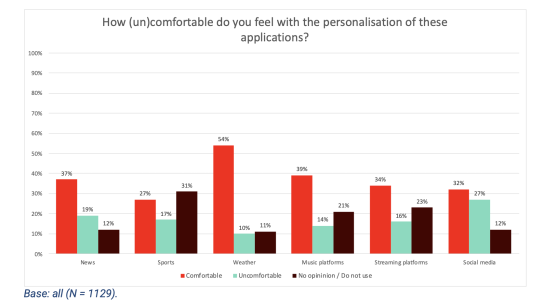
Flemish news users also show a similar attitude when it comes to entertainment, such as listening to music and streaming films and series: almost 40% of Flemish news users indicate that they feel comfortable with personalisation on platforms such as Spotify, Apple Music and Netflix, while the number of people who indicate that they do not feel comfortable with it is slightly lower than with news, around 15%.
Personalization on social media is clearly more sensitive: 32% of Flemish news users indicate that they feel comfortable with this, 27% do not. It is striking that this reluctance is mainly found among higher-educated Flemish people who may enjoy a greater awareness of this theme.
5. Only 1 in 5 Flemish people are satisfied with content moderation on social media platforms
Social media are an important source of information for many Flemish news users who are highly dependent on these platforms to stay informed. For example, 36% of Flemish news users indicate that they have used social media as one of their news sources and these platforms are the main source for 15% of Flemish news users.
At the same time, these platforms are not free of sins, on the contrary. Users rarely have insight into the black box systems, which means that the mechanisms behind content moderation are still a big secret. Content moderation on social media therefore remains a topic that raises more questions than answers.
Flemish news users also question the content moderation on these platforms. For example, 35% of them indicate that social media still do not remove sufficiently harmful content from their platforms. 15% of Flemish news users think that they are too eager to remove this type of content. Only 21% of Flemish news users think that content moderation on social mediaplatforms is sufficient.
The differences according to the political orientation of Flemish news users are striking. Right-wing Flemish people (28%) think that social media platforms remove too much content, compared to left-wing (16%) and centre-wing (13%) Flemish people.
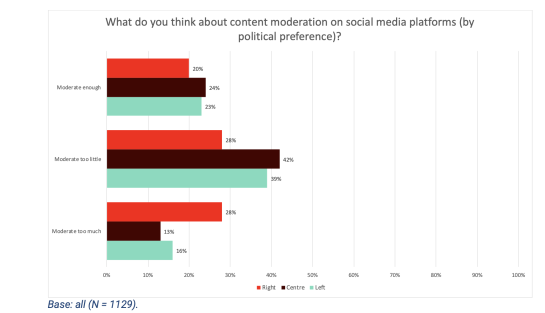
The considerable doubts and divisions about content moderation on social media should come as no surprise. How people define harmful content also varies greatly depending on the users themselves. What offends one person is not a problem for another. In the background, of course, there is also the societal debate about the tension between freedom of expression on the one hand and safeguarding a safe public sphere on the other.
6. People are concerned about disinformation, but that doesn't necessarily mean they verify questionable information
During the corona pandemic, Flanders experienced a first wave of disinformation. Concern about fake news online grew steadily to around 45% in 2025 (+25pp compared to 2018), and this across age, gender and socio-economic differences. Only among Flemish people with an outspoken political preference do we see a significantly larger share of people who are concerned about fake news (50%) than among Flemish people who do not indicate a particular political preference (35%).
This widely shared concern does not fully translate into the use of verification strategies though. Approximately one in four Flemish people do not verify possible fake news via any source. 26% do the verification based on one source and around 53% use 2 or more sources. Differences are visible between young and old. 61% of the -35 year olds indicate that they use
multiple sources. While for the +35 year olds this is about half. Flemish people with a lower income and less educated one also use proportionally fewer sources, with large differences between the less educated and the highly educated.
Furthermore, we can look at which source Flemish would consult to verify whether an online news story is false, misleading or fake. For this, people still seem to want to resort to established sources in the first instance. Approximately 40% would use an official source (e.g. a government agency website), 37% a news source they trust, and 29% a search engine. Of those who indicate that they would use a search engine to verify news, 47% indicate that they would look for an official source among the search results; 45% for a specialised site or expert;and 28% for Wikipedia. Only 20% would look for traditional news organisations or journalists among the results. Even lower in the ranking we find alternative news sources (8%), politicians
(3%) and influencers (3%).
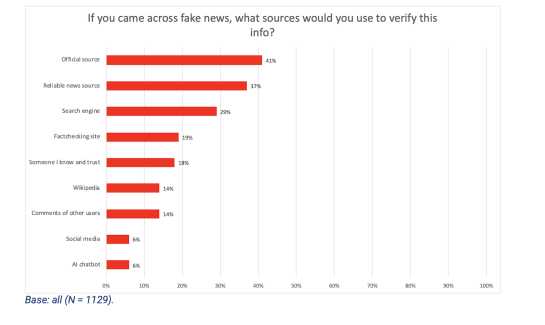
Social media is not exactly the place we would send people to verify news, and the Flemish people seems to be aware of this. Only a small number would use these platforms as a source of verification (6%).
It is noticeable that a larger share of -35 year olds find their way to these verification sources. Clear differences with +35 year olds are evident in the use of search engines (37% compared to 26%) and reading comments from other users under the news (20% compared to 12%). What also comes up in these age groups is the use of an AI chatbot. 11% of -35 year olds use this to check the factuality of the news, while only 4% of +35 year olds do this.
7. Influencers and activists are seen as the main sources of disinformation
After a strong upward trend since 2018, the number of concerned Flemish people seems to have stagnated at 45% in 2025: just under half of Flemish news users indicate that they are often concerned about which online information is correct and which is not. Especially the social media platform TikTok is associated with false or misleading information by almost six out often Flemish people. A large number of Flemish people are also concerned about the accuracy of the information on Facebook (55%) and X (48%).
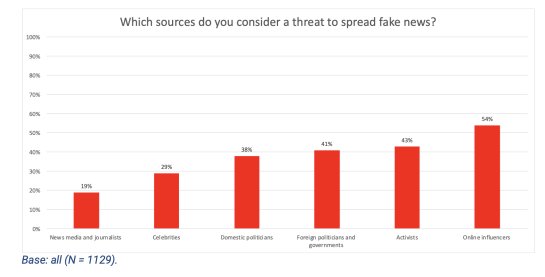
As for the information sources on these platforms, a majority of Flemish people (54%) mainly see influencers as the most problematic source of disinformation. It is striking that activists are also considered by 43% of Flemish news users to be spreaders of disinformation. In addition, foreign politicians or governments are seen as a threat by four out of ten Flemish people. It is striking that no small group of Flemish news users (19%) news media and journalists as spreaders of disinformation.
8. Half of young people have had media literacy training, and they rely more on news sources to check information
Less than one in five Flemish people indicate that they have ever followed a course in media literacy. Fortunately, there is improvement among young people. More than half (52%) of young people between the ages of 18 and 24 have ever participated in a media literacy course. By comparison: one third of 25-34 year olds; 14% of 35-44 year olds; 16% of 45-54 year olds; and only 9% of those aged 55 and over have ever followed such a course.
Does this also mean that more young people are turning to established sources of information? Not necessarily. After all, young people are also the ones who are more exposed to digital and social media. It should therefore come as no surprise that the percentage of young people between the ages of 18 and 24 who use AI bots and/or social media (15%) or the comment
section below news articles on social media (19%) to check information is significantly higher than in older age groups.
But what we do find is that of the young people between the ages of 18 and 24 who have had media literacy training, 50% use a search engine when in doubt, 45% consult a news source they trust, 18% consult a personal contact; and 28% consult comments from other users. For young people without training, this is respectively 26% for search engines, 30% for news sources, 12% for personal contact and 14% for comments.
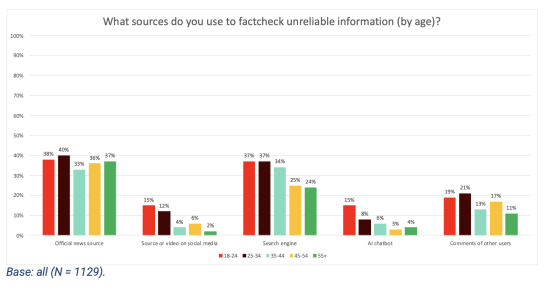
In addition, it appears that following a media literacy training mainly occurs among certain population groups: one in four highly educated people (25%) and one in three left-wing Flemish people (32%) have followed such a training. Within these groups, we do see a greater tendency to check the reliability of information via official news sources when in doubt: 48% of highly educated people and 42% of left-wing people do this. In comparison: the use of AI-bots (4%) and social media sources (7%) for fact checking is noticeably lower among highly educated people. However, 21% of left-wing people and 17% of highly educated people regularly do consult comment section of news articles to verify information.
9. There is a great need for local news, but social media also fulfil this need perfectly
The Flemish news user has a wide range of local and hyperlocal news tot heir disposal. Major news organisations such as VRT NWS, HLN and Het Nieuwsblad focus on provincial and municipal news, in addition to the range of regional players such as Het Belang van Limburg, Gazet van Antwerpen and Krant van West-Vlaanderen.
Most Flemish people show interest in local news: about 75% indicate that they are to some extent interested in news about the city, village or region in which they live. A few caveats should be added to this. Firstly, 46% of Flemish news users indicate that they are somewhat interested in local news, compared to 40% who indicate that they are very to extremely interested in it.
Secondly, this interest is mainly found in older age groups. Among the over-55s, we find no less than 85% who are interested in local news, while among 18 to 24 year olds this is only 60% and 35% of them indicate that they have little to no interest in it. The lack of interest is strikingly pronounced in younger age groups: more than 30% of Flemish news users between 18 and 24 years old and between 25 and 34 years old show little to no interest in local news. Political preference also plays a role: 77% of Flemish news users with a pronounced political preference show interest in local news, while among Flemish news users without a pronounced political preference this is 66%.
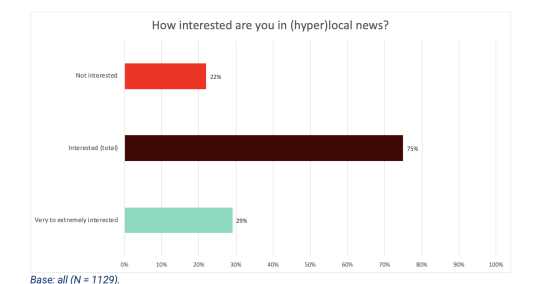
Thirdly, this relatively high interest in local news does not translate directly into its consumption. When asked what information about their place of residence they consulted in the past week, only 43% of Flemish news users indicated that they consulted local news stories.And when asked which source is the best for this, 49% indicated news media, 20% platforms (social media or search engines) and 13% specialised sites or apps. News media are therefore for many people neither the only nor the best source of local news.
Platforms therefore play an important role in local news provision. This is not a new story.More and more Flemish people consult news (exclusively) via social media. The importance, interest and use of (hyper)local news therefore comes with a serious caveat. Local news brands such as Het Belang van Limburg, Gazet van Antwerpen and Bruzz have only managed to reach
a limited share of Flemish people in the past 10 years, both online and offline. If (social media) platforms and large news organisations continue to meet local news needs, the viability of(hyper)local news organisations may be further compromised.
Conversation starter
| What do young people still expect from news? |
Engaging young people, the news consumers of tomorrow, in the news remains a challenge that not only concerns news media but also politicians and policymakers in a democracy. The figures on young people between 18 and 24 paint a picture thatgoes beyond the cliché of the indifferent ‘scrolling’ generation. Yes, they are increasingly turning away from traditional news consumption — 16% say they actively avoid it — but at the same time we see an audience that does search, compare, and ask questions. More than half have taken some form of media literacy training, and that makes a noticeable difference in how they deal with doubt or ambiguity in news reporting. Young people also use sources — think of comments under articles or even AI-tools — that are often labeled as unreliable by traditional news media, but which are part of their information ecosystem. Yet paradoxes remain. Young people have become more critical of AI in news production, but on average question its reliability less than older generations. They use social media and distrust those same platforms. They are disengaged, but not because they are indifferent — perhaps because they are too involved. These figures do not yet lead to concrete solutions, but they do allow us to increasingly sharpen the question of young people's involvement in the news:
|



